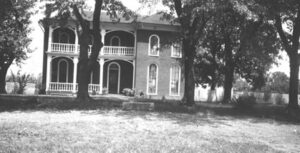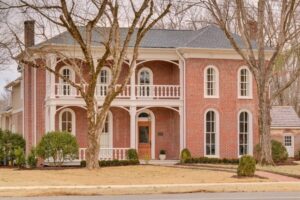(Note: This is part two in a blog series exploring the meaning of several popular phrases and their meaning to historic buildings and homes.)
Everything from the history of a building, whether it is discovering its stories or uncovering its secrets, lies in its architecture.
Many of us love historic architecture. Architecture provides us a peek into the past – surrounding us with reminders of beautiful and, at times, horrible occurrences in history.
Preserving the historic architecture of buildings and homes, however, is a never-ending task. Strict standards, regulated and monitored by the U.S. Department of the Interior Secretary’s Office through the National Park Service, can dictate anything and everything from paint colors, exterior modifications, and best practices for appropriately treating physical issues that may arise. These four distinctive yet interrelated standards – Preservation, Restoration, Rehabilitation, Reconstruction – exist to ensure the highest integrity for historic buildings is maintained. So, what does rehabilitation of a historic building mean?
In layman’s terms, rehabilitation recognizes the need to alter or add to a historic building or home to meet continuing or changing uses while retaining the building or home’s historic architectural character. The National Park Service defines rehabilitation “as the act or process of making possible a compatible use for a property through repair, alterations, and additions while preserving those portions or features which convey its historical, cultural, or architectural values.” (Vist the National Park Service’s guidelines on rehabilitation and treatments for buildings and homes to learn more.)
Over the past thirty-five years, the City of Franklin has undergone an economic revitalization resurgence, in large part to the preservation of its beloved historic Main Street but also the historic buildings and homes that contribute greatly to the quality of life in the community and the desire to live here. The rehabilitation of the Vaughn-McCall house on Murfreesboro Road is a part of Franklin’s beautiful gateway mosaic.
Examining the Historic Vaughn-McCall House
Listed on the National Register of Historic Places in 1988, the historic house was originally built in c1873 on six acres of land situated on the eastern edge of Franklin by Andrew Vaughn, a local businessman who owned a livery business and also a brick factory. Vaughn later sold the home (1887) to John McFerrin, after constructing a larger, ornate home in Franklin. The McFerrin family lived in the home for years until it sold to Thomas McCall.
Some of the prominent features of the house are located on the front façade including a two-story porch with square columns, vergeboard decoration, and milled balusters on both stories. The porch and eave of the house have paired brackets while the formal entrance has a glass-and-frame two-panel door with an arched single-light transom.
According to Williamson County historian Rick Warwick, electricity and running water was not a feature in the home until the 1950s. Garden Gates Homes, owned by Matt and Kara Christiansen, who purchased the home, worked with 906 Architects to breathe new life into one of the last remaining homes to be rehabilitated in historic Franklin.
Today, it is an excellent example of a fully rehabilitated historic home, retaining much of its fine interior craftsmanship, along with the staircase and mantels along Murfreesboro Road.

Image of the Vaughn-McCall House, Franklin, Tennessee, c1980s. Courtesy of the Williamson County Historical Society.
Awards in Preservation Excellence
For nearly 50 years and counting, the Heritage Foundation of Williamson County, TN recognizes individuals and organizations who pursuit excellence in preservation, restoration, renovation, and rehabilitation as well as infill, craftspeople, and heritage preservation of cultural landscapes.
In 2019, we awarded 906 Architects the Preservation through Rehabilitation -Residential Award for their rehabilitation of the historic Vaughn-McCall House located on Murfreesboro Road. As part of the ‘gateway to Franklin,” the c1873 Italianate gem, set back in a park-like setting along modern-day Highway 96/Murfreesboro Road, close to Pinkerton Park.
During its rehabilitation, special consideration was appropriately given to ensure the exterior of the home retained all of its historic features while additions in the rear of the home were carefully subdued to remain subordinate to the original dwelling, while providing 21st century amenities including a large, open kitchen, family room, and updated bathrooms. One of the key features central to rehabilitation of a residence is utilizing the home’s original footprint while providing a modern feel of the home.
With respect to the Vaughn-McCall house, the architects respected the home’s exterior and interior architectural characteristics by using original features of the home that allowed for expansion of existing spaces while incorporating original bricks from the kitchen fireplace around the modern stove. (To see the finished rehabilitation of the historic Vaughn-McCall House, please visit here.)

The Vaughn-McCall House, in 2019, Franklin TN. Image courtesy of the Heritage Foundation of Williamson County, TN. 906 Architects.
Governing Municipalities and Regulations for Historic Homes
I briefly mentioned regulations from governing municipalities in my previous blog on restoration of historic buildings and homes. The same governing municipalities will apply regulations for rehabilitation of a historic property. Your goals may closely align with regulations set forth by the National Park Service; however, if you purchase a historic building or home in a historic district or neighborhood, there very well might be additional regulatory guidelines in place you must follow.
Be sure to know! It’s necessary to do your homework; find a reputable architect and contractor who are highly skilled in historic building and home rehabilitations and are very familiar with your local municipality’s regulations and guidelines.
While many of us love historic buildings and homes, they often come with unforeseen challenges or problems that can cost more money than originally estimated. A historic rehabilitation of a building or home can be quite expensive, so again, remaining realistic about your budget will allow you to make the best decision for purchasing or maintaining the place you love.
Considerations When Rehabilitating a Historic Home
To recap, if you or anyone you know is considering a rehabilitation on a historic building or home, what should you do? Before you begin, ask yourself – what are your goals? What do you want to accomplish? Depending on its age, former inhabitants or important events that once happened at the historic building or home, its pertinent to do your research prior to beginning any rehabilitation work.
Our Preservation team highly recommends a property history and conditions assessment. Buildings and homes as well as their stories evolve over time, so please make sure you know the building or home’s history prior to taking a crowbar to your crown moldings. It will help guide you to reach the most appropriate decision for the historic building or home.
If you or someone you know is looking for a good roadmap, please contact Senior Director of Preservation and Education Rachael Finch at rfinch@williamsonheritage.org to set up a call or site visit! We help private property owners, real estate agents, and developers learn more about historic properties. Stay tuned for our next blog on one of the more common standards applied to historic buildings and homes when re-evaluating preservation – Reconstruction!